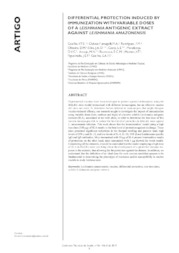Differential protection induced by immunization with variable doses of a Leishmania antigenic extract against Leishmania amazonensis.
Differential protection induced by immunization with variable doses of a Leishmania antigenic extract against Leishmania amazonensis.
Autoria: COELHO, V. T. S.; CHÁVEZ-FUMAGALLI, M. A.; RODRIGUES, F. M.; OLIVEIRA, D. M.; SILVA, J. A. O.; COSTA, L. E.; MENDONÇA, D. V. C.; ARAÚJO, M. N.; FOUREAUX, E. C. M.; MARTINS, V. T.; FIGUEIREDO, J. E. F.; COELHO, E. A. F.
Resumo: Experimental vaccines have been developed to protect against leishmaniasis using the BALB/c mice model immunized with different immunogens, but an effective vaccine still does not exist. To determine factors inherent to immunogens that might abrogate vaccine-induced efficacy, our research sought to investigate the impact of immunization using variable doses (low, medium and high) of a known soluble Leishmania antigenic extracts (SLA), associated or not with alum, in order to determine the best dose of this vaccine immunogen able to induce the best level of protection in BALB/c mice against L. amazonensis infection. This work shows that the immunization´ model using a high inoculum (100 µg) of SLA results in the best level of protection against challenge. These mice presented significant reductions in the footpad swelling and parasite load; high levels of IFN-γ and IL-12, and low levels of IL-4, IL-10, TGF-β and Leishmania-specific IgG and IgE antibodies. Mice immunized with 50 µg of SLA present intermediate results of protection; on the other hand, mice immunized with 1 µg showed the worst results. Considering all the elements, it could be concluded that the model employing a high dose of SLA in BALB/c mice can bring about the development of a protective immune response in the animals, thus allowing for the protection against the disease. In addition, we understand that the definition of an ideal dose for each vaccine candidate appears to be fundamental to determining the phenotype of resistance and/or susceptibility in murine models to study leishmaniasis.
Ano de publicação: 2019
Tipo de publicação: Artigo de periódico
Unidade: Embrapa Milho e Sorgo
Palavras-chave: Proteção diferencial, Tamanho inóculo, Vacina
Observações
1 - Por padrão são exibidas publicações dos últimos 20 anos. Para encontrar publicações mais antigas, configure o filtro ano de publicação, colocando o ano a partir do qual você deseja encontrar publicações. O filtro está na coluna da esquerda na busca acima.
2 - Para ler algumas publicações da Embrapa (apenas as que estão em formato ePub), é necessário ter, no celular ou computador, um desses softwares gratuitos. Sistemas Android: Google Play Livros; IOS: iBooks; Windows e Linux: software Calibre.
Acesse outras publicações
Acesse a Base de Dados da Pesquisa Agropecuária (BDPA) para consultar o acervo completo das bibliotecas da Embrapa.

